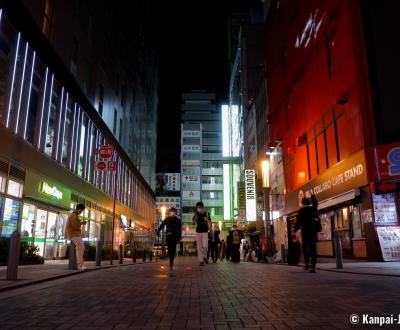Tokyo in the Dark During Spring 2021 State of Emergency
A new state of emergency has been declared in spring 🌸 2021 to face a surge of Covid-19 contaminations in Japan. The areas affected are:
- Tokyo, Kyoto, Osaka and Hyogo prefectures since April 25,
- Aichi and Fukuoka prefectures since May 12.
The state of emergency involves, among other things, self-restraint on going out, telework as much as possible, and for places that serve alcohol at night, such as restaurants and entertainment venues (including pachinko and karaoke) closing at 8 p.m. The governor of Tokyo requested a wider enforcement and the turning off neon signs during curfew hours to encourage people to go back home.
Spring 2021 state of emergency is one of the most rigorous since the beginning of the pandemic one year ago. We thus proceed to visit the usually liveliest nocturnal districts to feel the pulse of the megalopolis in the early evening hours, just after nightfall (sun sets before 7 p.m. in Japan).
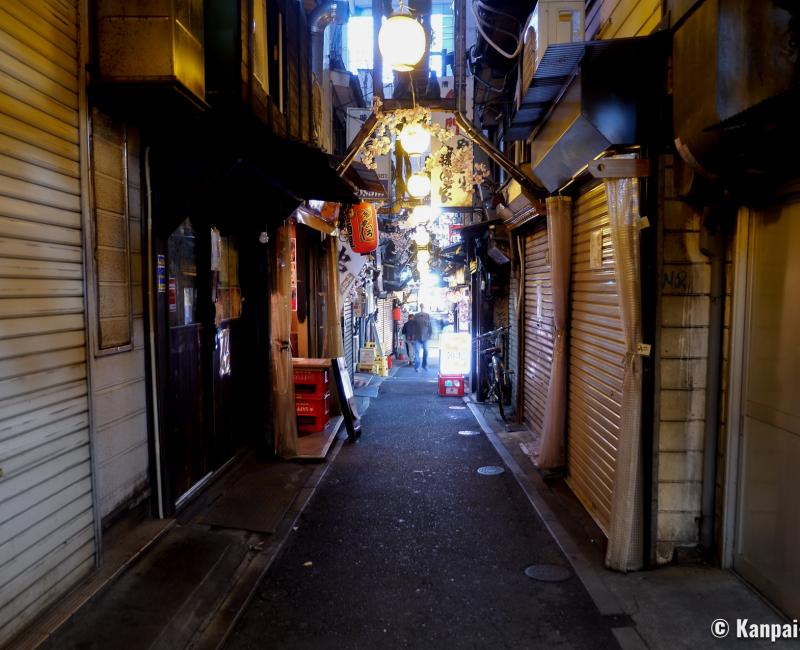
Shinjuku: Tokyo’s central district
We started our exploration from Nishi-Shinjuku, at the west of Shinjuku JR station. Located next to the electronic district, the business area characterized by countless glass towers, is totally empty, even though its large avenues were still lit up after 7 p.m. A few salarymen were heading back home, and traffic was scarce. The silent streets were only disturbed by the broadcasting of anti-covid spots from loudspeakers on vans to encourage people return home faster.
Office buildings had only a few floors lit up, and some were even completely turned off, such as Mode Gakuen Cocoon Tower and Sompo Japan Building. The Tokyo Metropolitan Government Building (Tocho), one of the landmarks of the area, seemed empty as well and its nice free observation deck, usually open until 11 p.m. was closed due to the state of emergency. The few open business hotels 🏨 showed however slight signs of activity.
Then heading towards Kabukicho at the east of Shinjuku station, we walked through Omoide Yokocho. The labyrinth of timeless alleys, whose numerous eateries usually filled the air with delicious grilled meat flavors, was extremely quiet. Tourists have been absent for more than one year and with the 8 p.m. curfew, most of the shops were closed anyway.
We finally reached Kabukicho, the night entertainment area in Shinjuku. It was a bit busier, but far from what it used to be when at the top of its bustling and "nefarious" reputation. The state of emergency was more or less enforced, some establishments staying open, and passersby (mostly young people) strolling around leisurely without paying attention to the hour. However, the neighborhood was not as lively and enlightened as usual. Many establishments had indeed closed earlier and turned off their display windows.
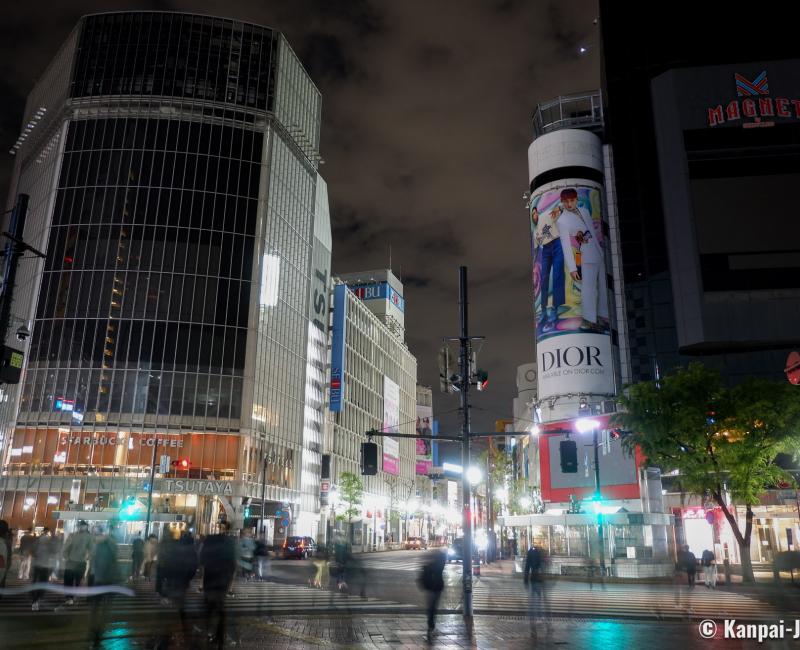
Shibuya: the evening meeting place of youth
A short ride on the Yamanote JR line brought us to Shibuya, another district renowned for its nightlife in Tokyo. The trains 🚅 were rather empty and all passengers could take a seat.
At Shibuya station’s "Hachiko" exit, still under extension works, the weak luminosity around the famous crossing was striking. Tokyo’s Time Square was barely recognizable: its giant screens were all turned off and Shibuya crossing was immersed in an extraordinary darkness, only alleviated by the streetlights on the sidewalks. The change was also in the sound ambiance: no more loud music and permanent commercials announcements. The absence of the noise and liveliness that characterized one of the biggest crossings in the world was stunning.
The rest of the walk was on the same page, Center Gai Street was almost deserted and definitely devoid of any of its hubbub and usual bustling atmosphere. We met only a handful of adventurous strollers and a couple of shops still open. Continuing toward Chuo-gai, at the south of Shibuya station, the desert was even more obvious and seeing such a ghost town brought a general feeling of malaise.
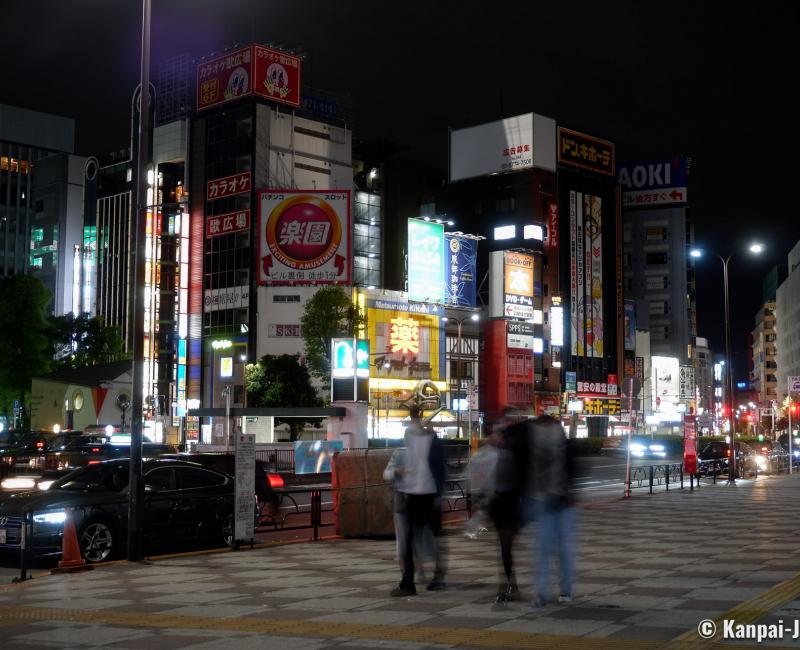
Ikebukuro: the trendy area in the north of the capital
Going north towards Ikebukuro and its station, the third most frequented in the country, we found it a lot quieter than usual. The skyscrapers on the eastern exit, the most popular, had their neon lights and large advertisement panels turned off.
Then we walked towards Sunshine 60-dori Avenue and its multiple and various entertainment and leisure venues. Not only there were no passerby, but all the shops, restaurants and the three giant arcades (Adores, Round One, SEGA) were closed. Sunshine 60, whose tower is visible between two buildings, did not seem much livelier with most of its floors in the dark.
Mikuni-koji, a Showa era back alley with a nostalgic retro feel, popular for its izakaya pubs opening until late in the evening, was immersed in the dark, without any customer in sight.
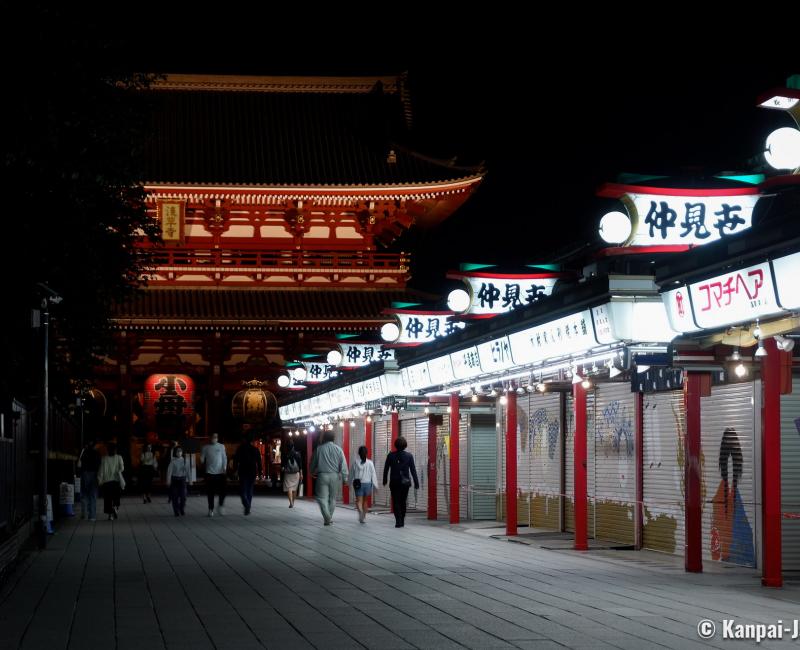
Asakusa: the ultimate touristic district
The nightly tour continued towards the east of the city, in Asakusa, the must-see for any tourist, including Japanese themselves. The deserted surroundings of Senso-ji’s entrance were forebodings of the quietness awaiting in the temple’s grounds. The great Kaminari-mon gate indeed was standing lonely in an eerie quietness undisturbed by Nakamise-dori avenue’s shops, closed day and night since April 25.
Want to know when Japan will reopen its borders to tourists? Subscribe to Kanpai’s Newsletter and get information on real time:
We quickly went up the shopping street, in a straight line permitted by the absence of crowd, and reached the second large gate: Hanzo-mon and the wonderful 5-story pagoda standing next to it. The large incense burner jokoro was extinguished and the doors of the main hall Hondo were closed, as well as the shopping arcades neighboring the temple. From there, the Tokyo SkyTree was visible, but its light-up was toned down compared to usual. However, the opportunity to enjoy the traditional district of Asakusa in a quiet atmosphere was quite pleasurable, provided that it is not forever of course.
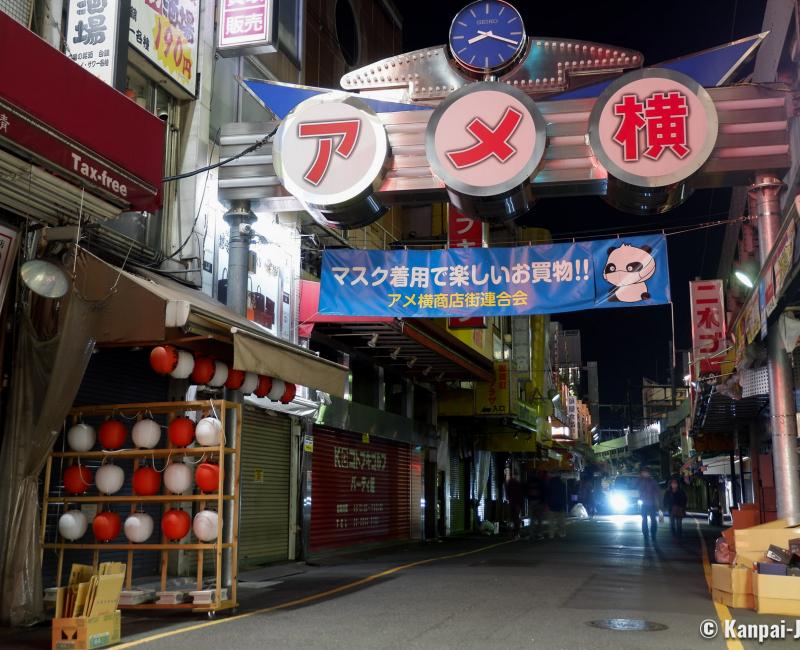
Ueno: the plebeian Ameyoko market
In the neighboring Ueno district, the permanent market Ameya Yokocho is an evening outing famous for its eateries’ affordable prices and the friendly atmosphere of its outdoor terraces. Most of the numerous restaurants were enforcing the state of emergency recommendations with orders ending at 8 p.m. and until the last customers finished their meal.
Afterwards, the street was soon emptied of passersby and merchants quickly packed and loaded their trucks with their merchandises. It was not 9 p.m. yet and trash bags were already aligned on the pavement and shops had their iron curtains pulled down.
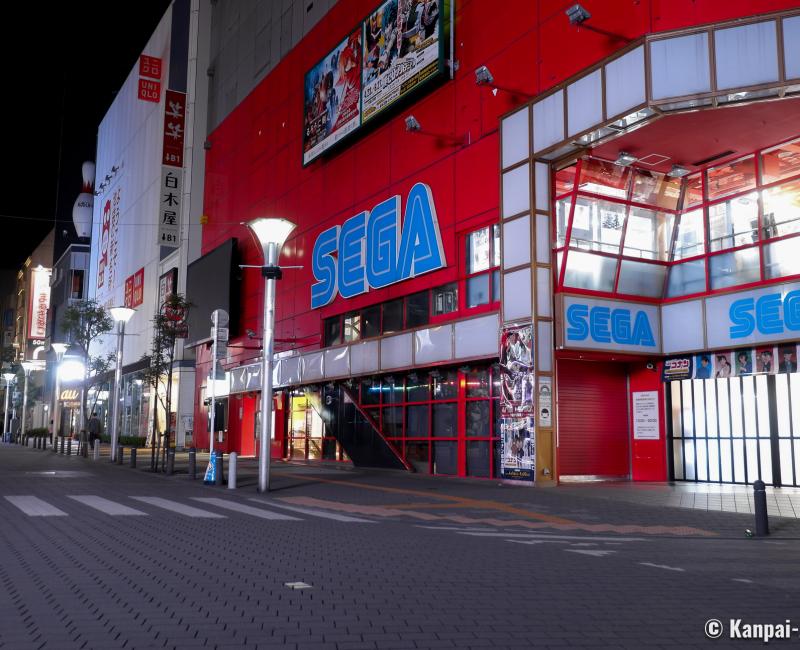
Akihabara: the otaku’s Mecca
Akihabara, the famous area dedicated to Japanese pop-culture such as manga, cosplay, arcade games and maid cafés is a little bit further south on the Yamanote line. The "Electric Town" exit, usually lively, was a lot less crowded the night we visited.
On the avenues, the department stores, such as the unavoidable Akihabara Radio Kaikan, as well as the tiniest shops in Akihabara Radio Center, specialized in electronic components retail, were closed. The otaku’s temple, Akiba Cultures Zone, was closed as well.
On the main avenue, car 🚙 traffic was scarce and walking was easy as there were not many pedestrians. On the sidewalks, some rare maid café employees dressed up as maids were on customer scouting duty. A couple of arcade games were nonetheless open, but there were actually very few options to spend time in the area.
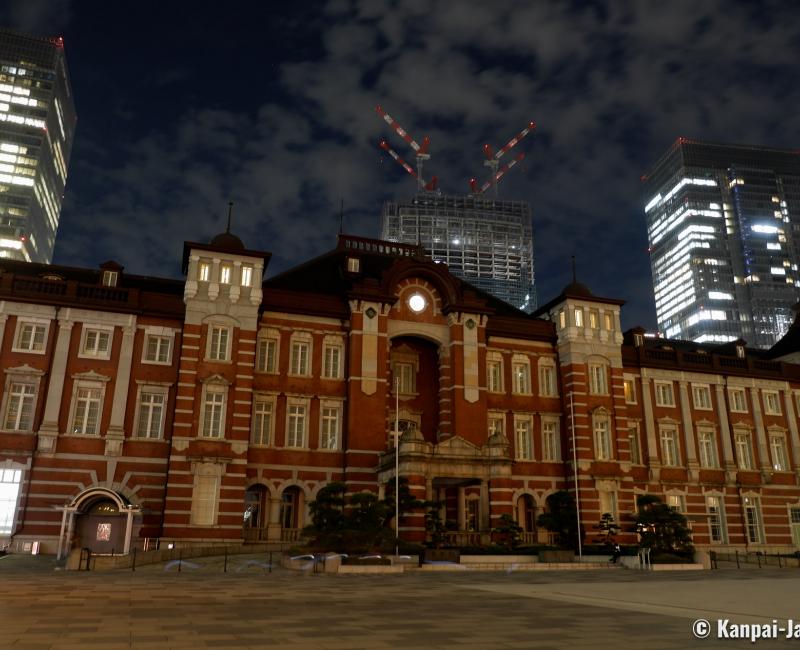
Marunouchi: the imperial district of Tokyo Station
The atmosphere changed in the more classy Marunouchi area. On the esplanade in front of the wonderful Tokyo Station, with its historical red bricks building offering an elegant contrast with the modern skyscrapers on Yaesu’s side, the only shiny illumination was the countdown for the beginning of the Olympic Games 🏅.
The front of the station, which usually benefits from a back light up, was then totally in the dark. The urban lighting gave a scarce light on the plaza emptied from travelers. Getting closer to Naka-dori entrance, the same ghost town atmosphere weighted on the quietness.
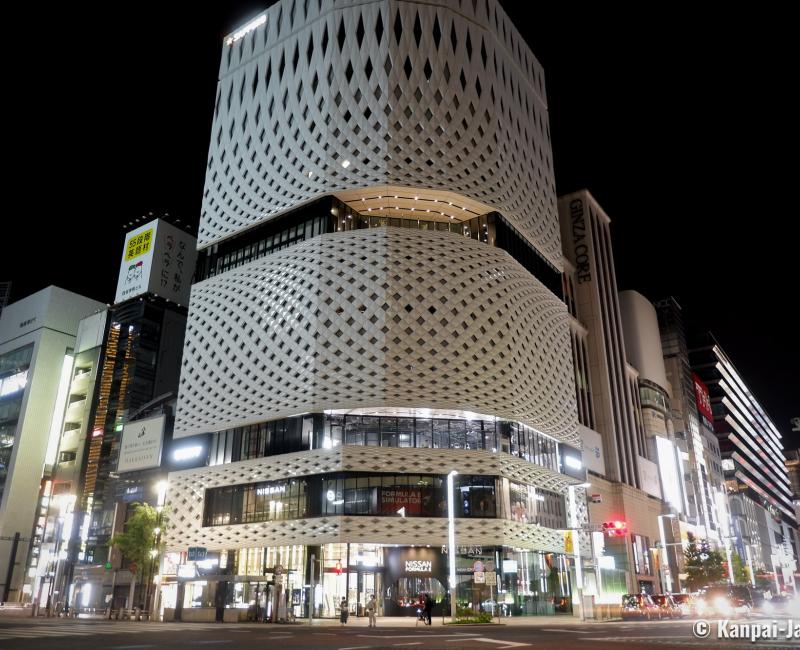
Ginza: the luxury brands’ window
Our nightly exploration of Tokyo ended in Ginza, an area usually beautifully illuminated by the luxury brands’ buildings lightings. But in the same way as all of the capital’s shopping streets, the stores were closed, be they independent ones or large shopping malls, such as Ginza Six or Mitsukoshi.
Ginza Crossing, the main intersection characterized by the century-old Neoclassical-style building of Wako department store with a curved façade, and the facing and more recent wonderful Ginza Place, has lost its appeal as all the neon were turned off. In contrast, the lights of the taxis lining up in hope of customers were blinding.
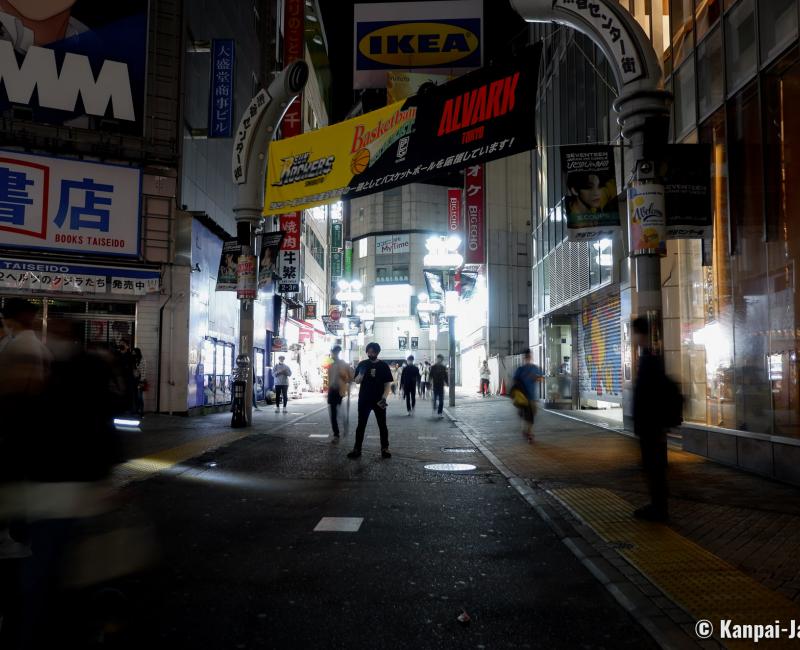
Emptied downtown under the night curfew
Seeing the dynamic Tokyo, a city usually bustling days and nights, in such a lethargic state is utterly uncommon. Tokyo Governor Yuriko Koike’s goal is to persuade the locals to stay at home rather than going out at night in groups. It seems she achieved this objective inasmuch as the city clearly lost its attractiveness with the lights turned off and the shops and restaurants closed.
However, we still encountered people, mostly young adults, who refused to cloister 24/24 at home and who still went partying in downtown Tokyo. They, of course, all wore a sanitary mask 😷 and stayed outdoor most of the time, especially since the beginning of spring. Operating restaurants tended to follow the instructions regarding the curfew, but others had unfortunately permanently closed down.
The state of emergency is not supposed to be a long term measure and hopefully the Coronavirus 🦠 contaminations will decrease permanently soon. However, the astounding delay in vaccination in Japan did not sustained optimism over the last few weeks. People’s moral is heavily affected by the mixed and strange feeling of appreciating the calm while worrying about the absence of life and joy. Many of us, including Kanpai’s team, are waiting for economical and touristic reopening as well, which will be the sign that the situation significantly improved.

